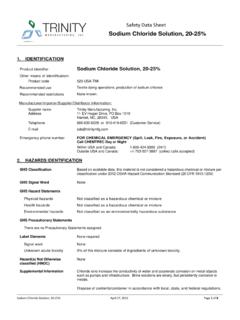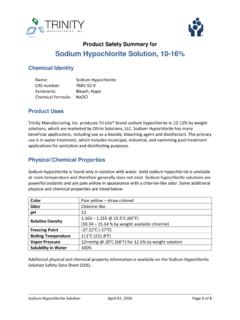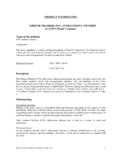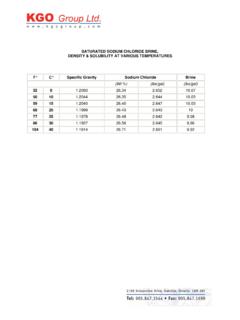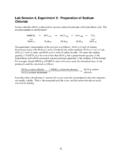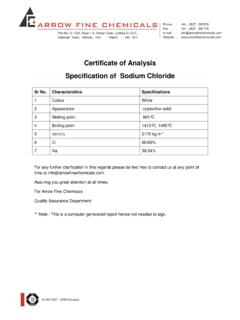Transcription of Product Safety Summary for Sodium Chloride …
1 Sodium Chloride Solution April 01, 2016 Page 1 of 4 Product Safety Summary for Sodium Chloride Solution, 20-25% Chemical Identity Substance Name: Sodium Chloride CAS number: 7647-14-5 Synonyms: Brine, Saltwater Chemical Formula: NaCl Product Uses Sodium Chloride solutions are used in numerous processes and are mostly produced at manufacturing sites by combining solid Sodium Chloride (NaCl) with water. Prepared aqueous solutions have limited commercial use. The largest industrial uses are in textile dying operations, production of chlorine and Sodium hydroxide and in the production of Sodium chlorate. Physical/Chemical Properties Sodium Chloride solutions are fairly neutral with a pH range from to They are slowly corrosive to metals and therefore proper materials of construction are critical in designing storage and handling systems.
2 Some additional physical and chemical properties are listed below: Color Clear to cloudy white liquid Odor Salty pH to Relative Density lbs salt/gallon water at C (60 F) Specific Gravity @ 60 F (average) Boiling Temperature >212 F (100 C) Vapor Pressure <water, which is psi @ 20 C (68 F) Additional physical and Chemical property information is available on the Sodium Chloride Solution Safety Data Sheet (SDS). Sodium Chloride Solution April 01, 2016 Page 2 of 4 Human Health Information Sodium Chloride solutions may be mildly irritating to skin, eyes and the respiratory tract. Eye splashes can cause a stinging sensation, itching, redness, and swelling. Direct contact with the skin may cause slight dryness, irritation, and possible dermatitis.
3 Inhalation of mists can result in irritation of the nose, throat, and upper respiratory tract. Such health effects are almost always reversible within the day of exposure. Although ingestion is highly unlikely in the workplace, accidental ingestion of large quantities could cause nausea, vomiting, excessive thirst, dehydration, diarrhea, and electrolyte imbalance. Additional data on health effects can be found on the Product Safety Data Sheet (SDS). Environmental Information Persistence & Degradability Sodium Chloride is not biodegradable or persistent. Bioaccumulation This Product has not been tested but based on its components, it is not expected to bioconcentrate. Aquatic Life Based on testing, Sodium Chloride is not classified as toxic to aquatic life.
4 Aquatic impacts Chloride in surface waters can be harmful to many forms of aquatic life. Aquatic species of concern include fish, macroinvertebrates, insects, and amphibians. Elevated Chloride levels can threaten the health of food sources and pose a risk to species survival, growth, and/or reproduction. Vegetation impacts Salt primarily causes dehydration which leads to foliage damage but also causes osmotic stress that harms root growth. Salt can disrupt nutrient uptake and cause injury to seed germination, stems, leaves, and flowering ability. Salt can lead to plant death and can also cause a colonization of salt tolerant species, such as cattails, thereby reducing species diversity. Wildlife impacts Damage to vegetation can have significant impact on wildlife habitat by destroying food resources, shelter and breeding and nesting sites, and by creating a favorable environment for non-native invasive species.
5 Additional data on environmental effects can be found on the Product Safety Data Sheet (SDS). Potential Exposure The most likely ways exposures can occur are: Manufacturing or Industrial Workplace Exposure: Sodium Chloride solutions have very low toxicity and exposure is considered to be without risk. Release during manufacturing or Sodium Chloride Solution April 01, 2016 Page 3 of 4 handling is of little concern although recommended Safety measures in the Product Safety Data Sheet should be followed. Consumer Exposure: Trinity Manufacturing, Inc. does not sell Sodium Chloride solutions in retail stores. Environmental Exposure: Release to the environment may occur during the manufacture, storage, or transport of Sodium Chloride solutions .
6 If a spill occurs, emergency personnel should wear protective equipment to minimize exposures. Avoid liquid entering sanitary sewer or storm drains or other waterways. Small amounts of residue may be flushed to sewer with plenty of water. More information on prevention and mitigation of potential exposures is available in the Sodium Chloride solutions Safety Data Sheet. Risk Management Sodium Chloride solutions are non-flammable, non-explosive, and non-toxic. As with all chemicals, care should be taken to reduce or eliminate personnel exposures and releases to the environment. Prior to using Sodium Chloride , carefully read and understand the Product Safety Data Sheet. The following are some risk management measures that are effective against these hazards: Provide eyewash fountains and Safety showers in areas where Sodium Chloride solutions are used or handled.
7 Flush eyes or exposed skin area with plenty of water for at least 5 minutes. To prevent eye contact during use or handling, protective eye wear (such as Safety glasses with side shields or splash goggles) are recommended. Airborne exposure is highly unlikely and no airborne limits have been established for this Product . In general, dilution ventilation is a satisfactory health hazard control. Wear appropriate chemical resistant gloves to protect hands. Butyl rubber, Latex, nitrile, neoprene, and vinyl provide excellent resistance. Work clothing that sufficiently prevents skin contact should be worn, such as coveralls and/or long sleeves and pants. In the event of a large spill, contain the liquid or block the material from draining to sewers and other water bodies.
8 Sodium Chloride Solution April 01, 2016 Page 4 of 4 Product Stewardship Additional technical assistance regarding physical property data and specific information for storing, unloading, and using Sodium Chloride solutions can be requested from Trinity Manufacturing, Inc. See contact information below. Regulatory Information The following is a Summary of regulations and guidelines that pertain to Sodium Chloride solutions (additional regulations and guidelines may apply): Sodium Chloride is listed in the US EPA Toxic Substances Control Act (TSCA) Inventory and in the Canadian Domestic Substances List (DSL) Federal Drinking Water Guidelines: EPA 250,000 g/L / Chloride ion Contact Information For additional information, call Trinity Customer Service at (800) 632-6228 or (910) 419-6551.
9 Trinity Manufacturing, Inc. PO Box 1519, 11 Hogan Drive Hamlet, NC 28345 This Product Safety Summary is intended to provide a general overview of the chemical substance. The information on the Summary is basic information and is not intended to provide emergency response information, medical information, or treatment information. For in-depth Safety and health information, refer to the Product s Safety Data Sheet (SDS), the Product s label, and other safe use and handling literature for the chemical substance.
